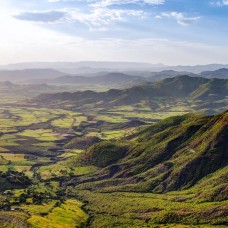Limu, Ethiopia
65% of Ethiopia’s coffee growing area is located within the Oromia region, with around 150,000 tons a year produced across 88 regions within 13 regions. The majority of the regions coffee is known as garden coffee due to the small plots of land with lower yields, as producer’s multi-crop with other cash crops to maximise their returns. Where research has been done on what are collectively known as heirloom coffees in Ethiopia, distinct varieties have been labelled with a numbering system more recently replaced with a name more local to where the plant was identified. Plants would be observed in the wild forests for distinct characteristics (such as disease resistance) and if not already listed, recorded. The first two digits represent the year in which it was discovered, the last three referring to the sample number.
The wet mill uses the local river for water to move beans through the depulper to the fermentation tanks, where the coffee remains for 36-48 hours before being cleaned again and moved to the drying tables for 10 days. The facilities here provide 14 tanks for fermentation and two soaking tanks for floating the beans when they come in so that they can maintain a constant flow of beans - and therefore maintain quality during busy harvest times.
The natural or unwashed coffees are placed on drying tables for 15-20 days depending on the weather, which stay within the compound of the farm so quality can be checked and controlled. Once dry, the beans are taken to the exporters dry mill facility for final QC and preparation for export.
| Region | Southern Nations |
| Altitude | 1900-2100 mASL |
| Varieties | 74-165, 74-140, 74-110, 74-112, 74-4, 75-227 |
| Tasting Notes | Honey, Lemon, Orange |
Related Products
Fazenda Palmital
In the mountains of the Serra So Pau S’Alho in the district of Cabo Verde, southern Minas Gerais, wa..
£6.00
Acatenango
The Acatenango cooperative is located in Acatenango, Chimaltenango on the slopes of the Acatenango v..
£6.00
El Eden
Forming one trisect of what is known as the Coffee Triangle (with Pereira and Manizales as the other..
£6.00
Rulindo
Coffee is picked and brought to the Kinini washing station (newly built in May, 2016) where it is se..
£6.00

